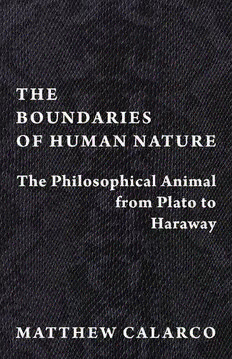Table Of ContentTHE
BOUNDARIES
OF HUMAN NATURE
THE
BOUNDARIES
OF HUMAN NATURE
THE PHILOSOPHICAL ANIMAL
FROM PLATO TO
HARAWAY
MATTHEW CALARCO
Columbia University Press New York
Columbia University Press
Publishers Since 1893
New York Chichester, West Sussex
cup.columbia.edu
Copyright © 2022 Columbia University Press
All rights reserved
Cataloging-in-Publication Data available from the
Library of Congress
ISBN 978-0-231-19472-3 (cloth)
ISBN 978-0-231-19473-0 (paper)
ISBN 978-0-231-55096-3 (electronic)
Columbia University Press books are printed on permanent
and durable acid-free paper.
Printed in the United States of America
Cover design: Elliott S. Cairns
Cover image: KAMONRAT/Shutterstock.com
CONTENTS
Introduction vii
1 Plato’s Pigs 1
2 Aristotle’s Wonderful Animals 12
3 Cynicism’s Dogs 26
4 Jainism’s Birds 42
5 Plutarch’s Grunter 51
6 Descartes’s Beast-Machine 59
7 Kant’s Elephants 70
8 Bentham’s Suffering Animal 79
9 Nietzsche’s Overhuman Animal 89
10 Derrida’s Cat 99
11 Adams’s Absent Referent 111
12 Plumwood’s Crocodile 124
13 Haraway’s Companion Species 131
Notes 145
Index 161
INTRODUCTION
We are living through a simultaneously thrilling and
fraught era with regard to animals. On one hand,
our knowledge of animals is more extensive and
expanding more rapidly than perhaps in any other age in human
history. Living animals are subjects of detailed ethological stud-
ies that lead daily to remarkable discoveries concerning their
cognitive abilities and social lives. In addition, archaeology and
evolutionary science have helped to reconstruct the rich history
of animal life on earth at a level of detail that was unthinkable
even fifty years ago. On the other hand, animals are today suf-
fering from unprecedented rates of extinction and unthinkable
forms of violence. If current trends continue, the earth could lose
30 percent of its animal species in the coming decades and rates
of animal slaughter could double by 2050.1 Given the increasing
appreciation many people have for the richness and wonders of
animal life, there has been a corresponding desire to find a way
collectively to change course and build a more promising future
with our planetary kin.
Although increased scientific knowledge of animals is cer-
tainly crucial to such a project, one of the main claims of
this book is that acquiring this knowledge is insufficient for
viii (cid:89) Introduction
generating the change of heart and transformation in values
and practices required to address these problems. I argue that
philosophy figures prominently in any project of reorienting our
individual and collective lives. As I hope to show, philosophical
discourse and practice contain essential resources for helping us
to reimagine not only who human beings are (one of its tradi-
tional concerns) but who animals are as well. It can also help
us think through how human-animal relationships might be
reconfigured in a more respectful and joyful manner. In brief,
philosophy provides us with important tools for helping bring
about an ontological2 and ethical revolution in our way of life.
I do not wish to claim that philosophy alone suffices for trans-
forming the current situation regarding animals; a wide variety
of discourses and perspectives are required for such a massive
task. Consequently, here I try to demonstrate how philosophy
can be supplemented by other approaches and perspectives.
Likewise, I do not suggest that the philosophical tradition has
been uniformly helpful for thinking about human-animal rela-
tions in a more respectful manner. Philosophers have served, on
more than one occasion, as the ideological support for dogmatic
forms of human-centeredness as well as problematic acts of vio-
lence against animals. Rather than providing a simple endorse-
ment or rejection of philosophy, I argue for an acknowledgment
of the mixed heritage that philosophy bequeaths to us and a
sense of responsibility for working through that heritage in view
of both its critical promises and its limitations.
The philosophers I analyze here belong primarily but not
exclusively to the Western tradition. The decision to include non-
Western traditions and perspectives has not been made solely
with an eye toward addressing the ethnocentricity of the philo-
sophical canon (which is undoubtedly a critical limitation) but
also with the recognition that novel and insightful approaches
Introduction (cid:90) ix
and ideas can be garnered from other heritages.3 Furthermore,
I suggest that additional, crucial resources for rethinking animal
life and relations in contemporary critical theories and bodies of
knowledge circulate on the edges of mainstream philosophy.4 In
taking this broad approach to theory, I join a whole host of prac-
titioners in the field of animal studies who have been making the
case for the past two decades that doing justice to the richness
and complexity of the more-than-human world requires devel-
opment of a correspondingly rich and complex set of theoretical
frameworks and perspectives.5 Although I am not able to touch
on all the fields that might be used to supplement and challenge
traditional philosophies, I hope to introduce you to some of the
more influential perspectives in this regard.
Another overarching aim is to suggest, echoing Jacques Der-
rida (whose work is discussed in chapter 10), that the animal
question is one of the central axes that organizes philosophi-
cal reflection.6 To be sure, such centrality is not often explicitly
affirmed, even by philosophers who spend a significant amount
of time reflecting on animals. But I aim to help make the case
that several of the central areas of philosophical inquiry—from
ethics and politics to epistemology and ontology—are grounded
on claims about human and animal natures and their relative
value and importance. In brief, it should be evident throughout
the text that even in their most abstract speculations philoso-
phers never stray far from animals.
I cannot hope to offer a comprehensive treatment of the
place of animals in philosophy in this brief book, so the tour is
necessarily selective.7 Ultimately, my aim is to help you think
with, through, and against certain key philosophers who have
important and influential ideas to offer in the ongoing devel-
opment of animal philosophy. This approach is guided by cer-
tain normative commitments, central among them being that

